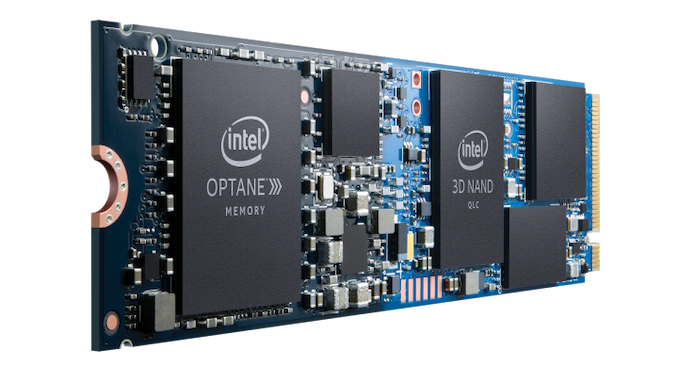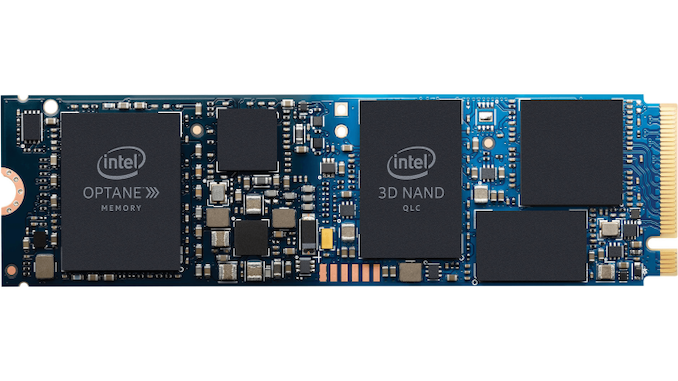New Generation of Optane M.2 SSDs Coming Soon
by Billy Tallis on January 8, 2019 2:30 PM EST
Intel's Optane products so far fall into one of two categories. At the high end is the flagship P4800X enterprise SSD and its derivatives for the enthusiast market. At the low end are the small M.2 modules intended primarily for caching use. It's this latter category that is being upgraded from PCIe 3x2 to a PCIe 3x4 host interface, moving the cache drives and small Optane SSDs more toward the mainstream NVMe SSD market.
Based on leaked roadmaps, we know that the original Optane Memory and its refresh Optane Memory M10 are being replaced by the new Optane Memory M15, codenamed Carson Beach. The Optane SSD 800P is being replaced by the new Optane SSD 815P, codenamed Bombay Beach. Capacity options are changing slightly for the M15 cache modules, which offer 16GB to 128GB in M.2 2280 form factor and 16GB to 64GB in M.2 2242 size. The Optane SSD 815P will be available in the same 58GB and 118GB capacities as the 800P.
| Intel Optane Consumer M.2 Product Lineup | ||
| First Generation | Second Generation | |
| Caching Modules | Optane Memory (16GB, 32GB) Optane Memory M10 (16GB, 32GB, 64GB) |
Optane Memory M15 (16–128GB, PCIe 3x4) |
| Standalone SSD | Optane SSD 800P (58GB, 118GB) |
Optane SSD 815P (58GB, 118GB, PCIe 3x4) |
| Hybrid NAND+Optane | Optane Memory H10 16GB+256GB, 32GB+512GB, 32GB+1TB PCIe 3 x2+x2 |
|
It appears that Intel is continuing with the rather confusing mismatch of advertised capacities between the Optane Memory and Optane SSD products. In reality, the Optane Memory 64GB and Optane SSD 58GB products have the exact same usable capacity, and the same will hold true for the 128GB vs 118GB. The smaller advertised capacities are more in line with how SSD vendors traditionally relate claimed GB to actual usable capacity, while the Optane Memory parts are advertising the nominal raw capacity of their 3D XPoint memory without reflecting space used for error correction or spare area for defect and wear management.
The system requirements for the above Optane products are unchanged from their predecessors. Optane Memory caching requires a Kaby Lake or newer platform and the use of Intel's Optane Memory storage drivers for Windows. Otherwise, both the M15 and 815P are standard NVMe SSDs that can be used as regular data or boot drives in any system that supports flash-based NVMe SSDs.
The third new Optane product is by far the most interesting: the Optane Memory H10 with Solid State Storage, codenamed Teton Glacier. Where previous Optane Memory products have been intended to serve as a cache in front of a mechanical hard drive, the H10 is Optane caching for QLC NAND, with both 3D XPoint and flash memory on the same M.2 module. The H10 bundles 16GB of Optane cache with 256GB of QLC NAND, or 32GB cache with 512GB or 1TB of QLC.
So far, Intel has only shared a mock-up rendering that looks like an Intel 660p and Optane Memory module squeezed onto one M.2 2280 card, but with enough changes to the layout that it doesn't appear to be just a photoshop of images of the two existing products. The first half of the board appears to contain the same Silicon Motion SM2263 controller used on the 660p, and one package each of DRAM and QLC NAND. The second half of the board looks like an existing Optane Memory module, with its own controller and 3D XPoint memory packages. We're not sure if this photo is an accurate representation of the real product, but it indicates that two PCIe lanes are routed to the SM2263 controller and two to the Optane controller. This suggests the Optane Memory H10 will appear to the host system as two different NVMe SSDs, and will likely require PCIe port bifurcation support to operate a PCIe x4 M.2 slot as two PCIe x2 links. This could potentially limit compatibility to M.2 slots that use PCIe lanes provided by the PCH. Officially, the Optane Memory H10 will require a Whiskey Lake or Coffee Lake platform. Unofficially, this may be the first Optane product that doesn't work out of the box as a plain NVMe SSD on any platform that supports NVMe. The dual-controller nature of the H10 means that the SSD caching functionality still depends on driver software, and is not managed transparently by the SSD itself. Intel will have to develop a unified 3D XPoint+3D NAND controller to pull that off.
Intel has not formally announced the M15 or 815P, but they have put up a product page for the H10. The Optane Memory H10 is planned for release in Q2 2019 with OEM systems from the usual suspects: Dell, Lenovo, HP, Acer, ASUS, and unspecified others. We expect the M15 and 815P to arrive at the same time or sooner.
Source: Intel











27 Comments
View All Comments
JoeyJoJo123 - Tuesday, January 8, 2019 - link
Looks cool I guess, but I guess I'm still not particularly interested. Kind of need to know if the pricing will be competitive.From the onset, it seems like a mistake. Pairing relatively consumer-unwanted Optane with relatively consumer-unwanted QLC NAND storage for an accelerated QLC M.2 ssd at 256/512/1TB sizes. Could it work out and be a great product? Yeah, at the right price. But given that both these technologies are in relative infancy compared to the TLC + DRAM technologies we have on tried-and-true and now pretty affordable M.2 drives, these things need to be priced really well to move in volume. And given Intel's at the reigns here, I don't expect great pricing to happen here. *shrugs*
Billy Tallis - Tuesday, January 8, 2019 - link
I'd rather see a unified single-controller drive with transparent caching and enough 3D XPoint that it doesn't need any DRAM. But I don't expect Intel to produce such a product, if only because it would be a cross-platform drive instead of tied to Intel chipsets. Micron might, if their in-house controller team starts delivering real products.IntelUser2000 - Tuesday, January 8, 2019 - link
They can do this. Aside from arbitrary reasons(locking out AMD), I don't think they are ready yet. They just got Optane working. A controller that works with both is a significant change and may take 2-3 years to do so if they do it fast. It's a chip after all. You have to design it, put it into silicon, test to make sure it works properly, and validate it.drexnx - Tuesday, January 8, 2019 - link
that was my response too, "yeah, it's cool, but why bother?"ccHephaestus - Tuesday, January 8, 2019 - link
QLC is cheap for high capacity, but its draw back is performance,Optane is blazing fast, but its expensive for high capacity.
To me, It makes perfect sense to use one to supplement the other.
It has the same question any product has, whats the cost? whats the performance?
We will have to wait and see. Still a unique product either way
Death666Angel - Wednesday, January 9, 2019 - link
QLC isn't that cheap at the moment and the proof that it will become significantly cheaper than TLC is still not made. TLC was cheaper than MLC the moment it came out (and had some performance issues down the line, that I never noticed with my original 840). QLC is not cheaper than any comparable TLC drive and the yield issues seem to be significant. QLC was also not marketed as a play to replace performance TLC drives, it was meant to substitute magnetic drives. I don't need more than a medium size SLC cache for an HDD substitute.Don't get me wrong, I'm still interested in these kinds of products, as I was in hybrid HDDs. They could work. Coming from Intel though gives me a lot of pause, since they like to price themselve out of competition. And hybrid HDDs never really caught on because SSD prices dropped fast enough and the performance uplift wasn't large enough. Something that can easily happen here as well.
name99 - Monday, January 21, 2019 - link
The question is not why use cache on a QLC drive, it’s why is OPTANE cache better than good-old SLC cache?TelstarTOS - Sunday, February 24, 2019 - link
it isn't.zodiacfml - Wednesday, January 9, 2019 - link
Capacity vs price is still not right. Once that happens, I will be all over this.Consumers SSDs are plenty fast except when it does randoms such as doing a Windows update or installation where Optane has an advantage.
ScouserPcgamer - Tuesday, January 8, 2019 - link
I personally see it as a pointless product M.2 SSD are falling in price as practically every brand is doing them from Gigabyte to Corsair, these would of been usefull 5-8 years ago were now i dont think they have much point, if the put Intel Optane in a HDD for example 5400RPM/7200RPM i think that will make a massive difference i know Seagate do the SSHD i am suprised WD haven’t bothered to try make one yet